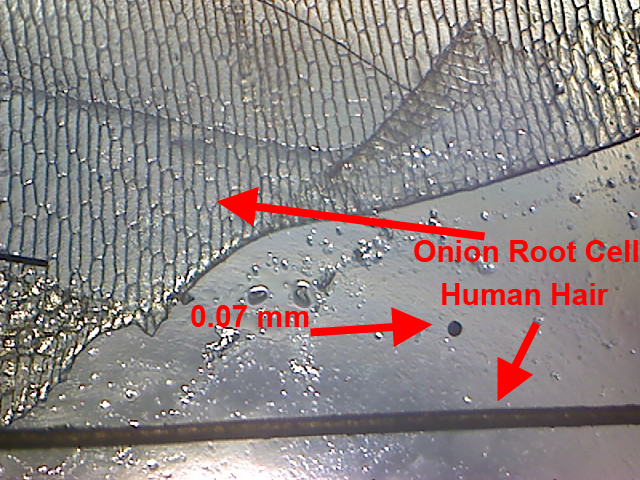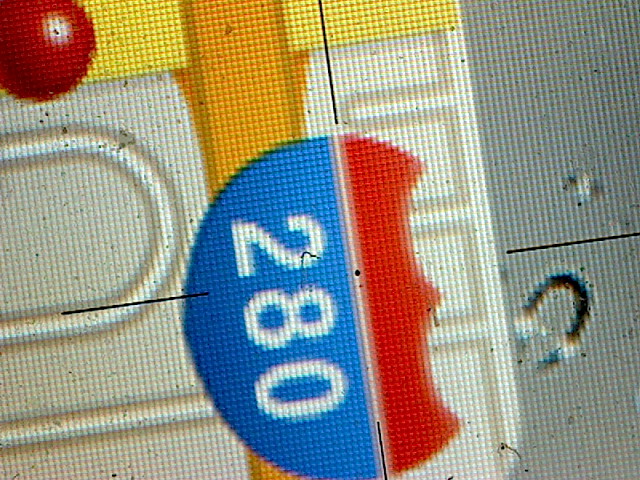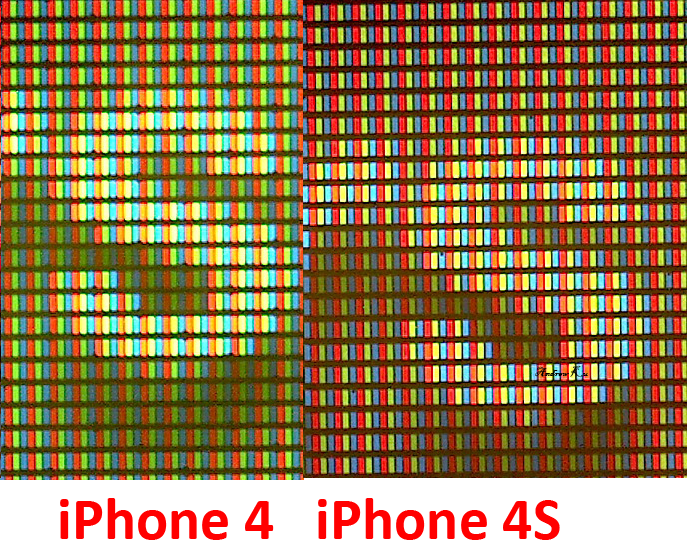Apple iPhone 4S, Part 2: Battery, Camera, And Display Quality
Display Performance, Examined: In Microscopic Detail (Literally)
You could make the case that our almost year-old iPhone 4 sample is suffering from the effects aging, which could explain the difference in brightness and color temperature, but given some of the significant differences, we powered up the lab microscope for a closer look.
Technically, we're supposed to calibrate our microscope for scale, but I decided to include two pictures instead to give you an idea of how small these subpixels really are.
This first picture is a sliver of a stained onion root cell and a single human hair on top of a stage micrometer slide (used in biological sciences to make measurements). The little dot in the corner has a diameter of 0.07 mm. That comes out to 70 μm.
This is the same dot superimposed over the iPhone 4S.
The subpixels start to come into focus when we adjust the zoom.
At the microscopic level, we see a completely different subpixel structure, which means that Apple quietly slipped in a new design or is using a different hardware vendor to supply the panels for its 4S.
Get Tom's Hardware's best news and in-depth reviews, straight to your inbox.
Current page: Display Performance, Examined: In Microscopic Detail (Literally)
Prev Page Display Performance, Examined: The Benchmarks Next Page Display Performance, Examined: Color Gamut-
compton If the display really is improved, then I think I'm going to have a hard time resisting the 4S (not that the 4's display was anything but great to me, but it's just more icing on the S cake). Good displays of any kind are rare in some (many) segments, but mobile devices wouldn't have great displays now had not Apple has pushed the market forward to IPS (and other higher quality type) panels in tablets and phones. If only they could do the same for laptops...Reply -
rhangman From what I have read there are two different displays, one colder, one warmer. According to this review the warmer one is better, but people seem to prefer the blue screen.Reply
I believe the 4 also came with yellow/blue screens, if so the screen is nothing new. -
mayankleoboy1 ReplySiri is more of a mixed bag. It's useful, but by no means smart.
you want a human comparable AI running inside a phone?
of course siri is basic. and so is all other AI. -
deputc26 "It's more flexible under a wider range of lighting conditions and benefits from higher pixel density." Benefits from higher pixel density??? A camera sensor? I assume you mean photosites rather than pixels. Except that the smaller photosite... the worse they are not the metter. I think you should say it "benfits from higher resolution and does not lose per-pixel detail due to the increased quantum efficiency of the new sensor"Reply -
Kamab Maximum white luminescence and max contrast ratio are going to have a direct correlation, aren't they? I think the reason they didn't mention a display upgrade is because there isn't one. They simply got their LCD panels from a different vendor (probably cheaper). I can see the camera upgrade being handy though.Reply
The IP4S to me feels like an attempt by apple to lower expenses by leveraging existing architectures (IP4) and components (processor from iPad2) to drive profit margins.
The only reason someone with an IP4 should upgrade to an IP4S is that due to extreme demand you could probably sell back your IP4 for 350-400$ and know that your 4S will retain value for a long time as well.
-
acku Reply9521688 said:Maximum white luminescence and max contrast ratio are going to have a direct correlation, aren't they? I think the reason they didn't mention a display upgrade is because there isn't one. They simply got their LCD panels from a different vendor (probably cheaper). I can see the camera upgrade being handy though.
The IP4S to me feels like an attempt by apple to lower expenses by leveraging existing architectures (IP4) and components (processor from iPad2) to drive profit margins.
The only reason someone with an IP4 should upgrade to an IP4S is that due to extreme demand you could probably sell back your IP4 for 350-400$ and know that your 4S will retain value for a long time as well.
Yes and no. I dialed back luminance for some other lab testing and we certainly still saw a difference in color temperature and gamma. This kind of goes back to the yellowing issue seen on some iPhone 4s (plural not 4S), which may be possibly related, but the replacements that Apple sent out were suppose to have their yellow tint fade away over time. At least that was the story... The bottom line is that there is a difference between the two models.
I suppose one could argue that its a cheaper panel. The one thing that the microscope shows is that it definitely is a different panel. This isn't just a weird chemical film that's plaguing a batch of Retina displays. This is actually a different panel at the subpixel level, because the subdomain structure has also changed.
7200 K is closer to the standard 6500 K, but without proper color calibration though, I'd say blue looks more natural. That's also reflected in the "standard calibration" most manufacturers use on their LCD displays.
I don't know about the only reason to switch. There certainly are many reasons not to use an iPhone, and I would be remiss to recommend one to everybody. In the US, the real problem is the inflexible carrier plans and the requirement to buy a data plan. Of course, this is a problem with all smartphones, so not just applicable to the iPhone.
Cheers,
Andrew Ku
TomsHardware.com -
jecastej Great review with plenty of images to show the differences in display and camera quality. The iPhone 4S really shows better definition under regular and more extreme light conditions and also the white shows a better balance. Also I can distinguish better color saturation on the "S" that maybe helped by the higher resolution. Siri shows to be based on a set of commands, but in the end the user will speak comprehended logical commands. It is not that fun as a real companion but we may get there someday.Reply


